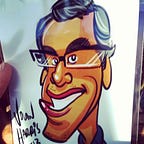Why is X algebra’s variable?
Or, how an anonymous typesetter set history’s course.
Question: x is now synonymous with the unknown. Why is it algebra’s first variable?
Answer: In 1637, a French printer decided to use the letter ‘x’ to represent algebraic variables.
Welcome to Costs Matter, a series that asks different questions all of which have the same answer: to better manage costs. The costs are usually economic though not always. The series focuses narrowly on the impact of costs. It does not claim these costs are the sole cause. To read more in the series, visit https://medium.com/galileo-onwards/costs/home.
René Descartes invented the mathematical field of analytic algebra in his book, La Géométrie, published 1637. Attribute your love or hate of algebra to him. (Incidentally, the same man also puts the carte in the Cartesian coordinate system, came up with the famous cogito ergo sum, which translates to “I think, therefore I am”.)
The story goes that when he sent his manuscript, his printer offered him three choices to represent variables — the letters ‘x’, ‘y’, and ‘z’. Descartes said he didn’t care and his printer chose ‘x’ because it was the least commonly used letter in French.
Back then, books were printed by painstakingly arranging individual alphabets (called movable type) in blocks. The alphabets were mirror images (The movable type of “ɑ” was “ɒ”), arranged right to left (“Radical” became “lɒɔibɒЯ”). After arranging them, they were then painted with ink, and a paper pressed on them. (Hence the term press.)
To print a page, you would need as many movable type blocks as letters on the page. You would need more of some letters than others, for example, in English the letters “E”, “T”, and “A”, are three most common letters. A page with 250 words averaging 4 letters per word would need around 1000 movable types. And since printers don’t want to have a 1000 unique movable types of every alphabet (26000 upper case + 26000 lower case), the optimized by keeping only the most common letters most. Samuel Morse, when design the Morse code used the following frequency distribution:
Thus, we have a parsimonious person paring printing prices to thank (or blame) for algebra’s x.
References
The story of Descartes and his printer occurs in Karen Olsson’s The Weil Conjectures (published 2019).
